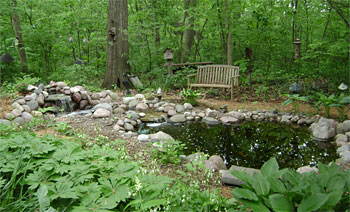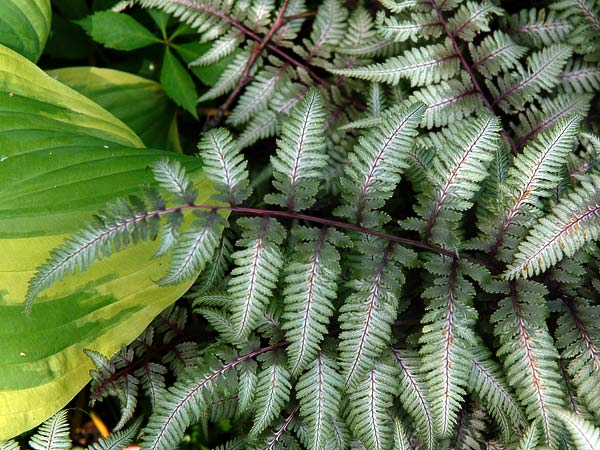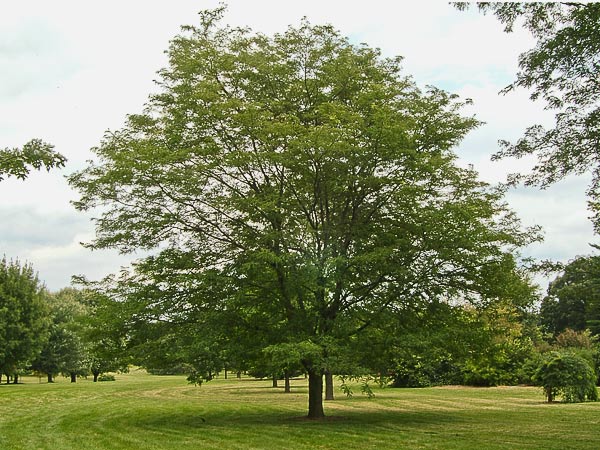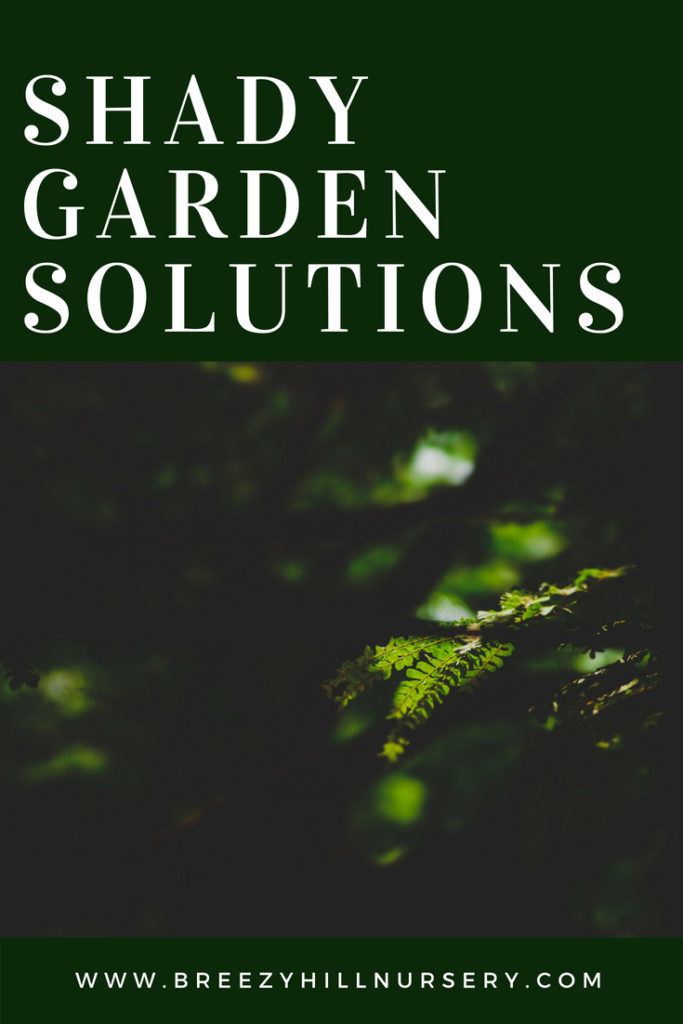BY KARI-LYNN O’NEIL
I had stumbled upon the Bermuda Triangle of shady garden spaces.
I have inherited a Japanese garden. Or rather, I have inherited an old giant pine tree with a gravel paved path with a few giant boulders butted against a wooded back lot. I discovered it only after I made the trip back to uncover it from the five foot mangle of weeds that insisted taking over the area.
In fact, these weeds were the only thing that grew there. I could tell by the dried out holes left in the landscaping fabric that someone had made attempts to plant beneath these old trees. There were petrified remains of lifeless straggles here and there, a variety of thorny stemmed bush or thickly branched specimens which hadn’t survived.
Either I was preceded by a very poor gardener, or I had stumbled upon the Bermuda Triangle of shady garden spaces. If it hadn’t been for the plethora of 5 foot weeds, I would have suspected the whole area barren.
Trees needs
Rather than spend a small fortune in plants, I decided to do some research. As it turns out, there are a quite a lot of variables when it comes to successful shade gardening under trees. Here’s what you need to keep in mind:
- The tree’s needs come first
- Determine how well your tree tolerates root disturbance
- Avoid damaging the trunk and roots
- Proper underplanting and aftercare
Every tree has it’s own set of needs in order to thrive, so do your homework before you start digging up! You might be surprised to know even adding a few inches of soil under certain trees can cause it to suffer, or even die.
A tree’s canopy also needs to be taken into consideration. My tree for example, is a giant old pine. It not only doesn’t take kindly to it’s roots being shuffled about, but the giant canopy almost completely shields the light and rain from reaching anything beneath it’s cover. Additionally, the pine needles that drop in the fall steep the soil in acid.
My Japanese garden isn’t just a shade garden, it’s an acidic, dry, full shade garden
My Japanese garden isn’t just a shade garden, it’s an acidic, dry, full shade garden which requires very shallow plantings, spaced over a few years so everyone will be happy. Failure makes a lot more sense now, doesn’t it? (For a list of trees and how well they deal with root disturbance, see the bottom of this article.)
Protecting your existing Trees
The best way to avoid damaging your tree’s roots or trunk is to understand how they grow. Most trees stabilize themselves from winds by pushing major roots several feet into the soil. The rest of the roots are small, hairy or woody and only about 12-18 inches below the ground. They extend out to about the tip of its farthest branches in order to collect moisture.
When you’re planting beneath your tree, if you find a root 1 1/2 to 2 inches in diameter while digging a hole to plant, move your plant over to avoid slicing the root. Also, to protect your tree from insects and disease, never plant closer than 12 inches away from the trunk. Mulch should also stay at least 12 inches from the base to prevent rot and disease. Water and mulching your new shade garden will keep your plants and tree from competing for resources.
New plantings needs
Proper aftercare is required in order for your new garden to survive. You’ll have to monitor moisture conditions, watering weekly when rainfall is inadequate and spot watering in areas where the tree may be getting more water than the rest.
 You’ll also want to avoid fertilizing for the first year because your new plants need to establish their roots if they are going to survive in their new home. If you feel your plants are lacking, test your soil first. If needed, a general slow release fertilizer will help both your tree and plants alike.
You’ll also want to avoid fertilizing for the first year because your new plants need to establish their roots if they are going to survive in their new home. If you feel your plants are lacking, test your soil first. If needed, a general slow release fertilizer will help both your tree and plants alike.
If you’ve ever wondered why shaded areas in the woodlands have such dense growth, it’s due to Mother Nature’s organic recipe of twigs, leaves and other organic matter that decomposes and provides a wonderful compost enhancement to the soil. Many gardeners remove this debris and then replace it with store bought organic matter in the spring. Thanks to the green movement, many gardeners are opting to simply shred their fall clean up and lay the matter back down on their gardens to breakdown over winter.
My Japanese garden is coming into place, but is a slow process. I’ll be the first to admit I’m not the most patient gardener, so if you’re anything like me you probably don’t like the idea of waiting years to establish a garden beneath your tree. Here’s my secret: cheat! You would be amazed at how much space a few well placed planters take up. Adding sculptures, a place to sit or objects that can be moved until your plants fill in, are beautiful ways to keep your garden interesting!
For Your Reference
The most difficult shady areas are those under mature shady trees in which plants must survive in both dry and shady conditions. These plants generally do well in such areas:
Shrubs
Carolina allspice (Calycanthus floridus and cvs., Zones 5–9)
Cutleaf stephanandras (Stephanandra incisa and cvs., Z 3–8)
Ninebarks (Physocarpus opulifolius and cvs., Z 3–7)
Snowberry (Symphoricarpos albus var. laevigatus, Z 3–7)
Winterberries (Ilex verticillata and cvs., Z 5–8)
This Winterberry is a shrub that can tolerate full shade.
Perennials and grasses
Black snakeroot (Cimicifuga racemosa, Z 3–8)
Columbines (Aquilegia spp. and cvs., Z 3–8)
Foamflowers (Tiarella spp. and cvs., Z 3–9)
Japanese forest grasses (Hakonechloa macra and cvs., Z 5–9)
Japanese painted fern (Athyrium niponicum var. pictum, Z 5–8)
Lungworts (Pulmonaria spp. and cvs., Z 2–8)
Siberian irises (Iris spp. and cvs., Z 3–9)

Japanese Painted Fern can tolerate both shade and dry conditions.
These trees don’t like disturbance
Beeches (Fagus spp. and cvs., Zones 3–9)
Black oak (Quercus velutina, Z 4–8)
Buckeyes (Aesculus spp. and cvs., Z 3–9)
Cherries and plums (Prunus spp. and cvs., Z 3–9)
Dogwoods (Cornus spp. and cvs., Z 2–9)
Hemlocks (Tsuga spp. and cvs., Z 3–9)
Larches (Larix spp. and cvs., Z 1–8)
Lindens (Tilia spp. and cvs., Z 3–9)
Magnolias (Magnolia spp. and cvs., Z 3–9)
Pines (Pinus spp. and cvs., Z 3–10)
Red oaks (Quercus rubra and cvs., Z 5–9)
Scarlet oaks (Quercus coccinea and cvs., Z 5–9)
Sugar maples (Acer saccharum and cvs., Z 4–8)
Tolerates some disturbance
Hickories (Carya spp. and cvs., Z 4–9)
Hornbeams (Carpinus spp. and cvs., Z 3–9)
Ironwood (Ostrya virginiana, Z 5–9)
Redbuds (Cercis canadensis and cvs., Z 4–9)
Red maples (Acer rubrum and cvs., Z 3–9)
River birches (Betula nigra and cvs., Z 4–9)
Sourwood (Oxydendrum arboreum, Z 5–9)
Spruces (Picea spp. and cvs., Z 2–8)
Swamp white oak (Quercus bicolor, Z 4–8)
Sycamore (Platanus occidentalis, Z 5–8)
Is easygoing about disturbance
Arborvitae (Thuja spp. and cvs., Z 2–9)
Crab apples (Malus spp. and cvs., Z 3–9)
Ginkgos (Ginkgo biloba and cvs., Z 5–9)
Hawthorns (Crataegus spp. and cvs., Z 4–9)
Honeylocusts (Gleditsia triacanthos and cvs., Z 3–7)
Kentucky coffee tree (Gymnocladus dioica, Z 5–9)
Pecan (Carya illinoinensis, Z B5–9)
Poplars (Populus spp. and cvs., Z 3–9)
Silver maples (Acer saccharinum and cvs., Z 4–9)
White oak (Quercus alba, Zones 5–9)
Willows (Salix spp. and cvs., Z 4–9)

Honey locust not only can tolerate some soil disturbance from under planting them, they also cast a light shade that allows a greater range of plants to grow.


Comments are closed.